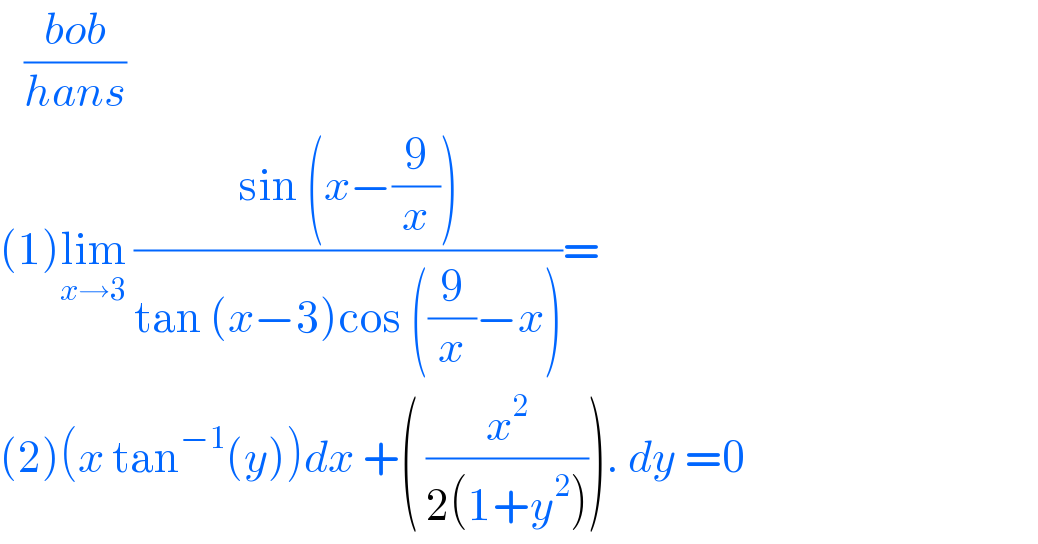Question Number 110350 by bobhans last updated on 28/Aug/20

$$\:\:\:\frac{{bob}}{{hans}} \\ $$$$\left(\mathrm{1}\right)\underset{{x}\rightarrow\mathrm{3}} {\mathrm{lim}}\:\frac{\mathrm{sin}\:\left({x}−\frac{\mathrm{9}}{{x}}\right)}{\mathrm{tan}\:\left({x}−\mathrm{3}\right)\mathrm{cos}\:\left(\frac{\mathrm{9}}{{x}}−{x}\right)}= \\ $$$$\left(\mathrm{2}\right)\left({x}\:\mathrm{tan}^{−\mathrm{1}} \left({y}\right)\right){dx}\:+\left(\:\frac{{x}^{\mathrm{2}} }{\mathrm{2}\left(\mathrm{1}+{y}^{\mathrm{2}} \right)}\right).\:{dy}\:=\mathrm{0}\: \\ $$
Answered by john santu last updated on 28/Aug/20

$$\:\left(\mathrm{1}\right)\:\underset{{x}\rightarrow\mathrm{3}} {\mathrm{lim}}\:\frac{\mathrm{sin}\:\left(\frac{{x}^{\mathrm{2}} −\mathrm{9}}{{x}}\right)}{\mathrm{tan}\:\left({x}−\mathrm{3}\right)\mathrm{cos}\:\left(\frac{{x}^{\mathrm{2}} −\mathrm{9}}{{x}}\right)}={L} \\ $$$$\left(\:{note}\::\:\mathrm{cos}\:\left(−{x}\right)=\mathrm{cos}\:\left({x}\right)\right) \\ $$$${L}=\underset{{x}\rightarrow\mathrm{3}} {\mathrm{lim}}\:\frac{\mathrm{tan}\:\left(\frac{{x}^{\mathrm{2}} −\mathrm{9}}{{x}}\right)}{\mathrm{tan}\:\left({x}−\mathrm{3}\right)}\: \\ $$$${let}\:{x}\:=\:\mathrm{3}+{h}\:;\:{h}\rightarrow\mathrm{0} \\ $$$${L}=\underset{{h}\rightarrow\mathrm{0}} {\mathrm{lim}}\:\frac{\mathrm{tan}\:\left(\frac{{h}^{\mathrm{2}} +\mathrm{6}{h}}{\mathrm{3}+{h}}\right)}{\mathrm{tan}\:{h}} \\ $$$${L}=\:\underset{{h}\rightarrow\mathrm{0}} {\mathrm{lim}}\:\frac{{h}^{\mathrm{2}} +\mathrm{6}{h}}{\left(\mathrm{3}+{h}\right).{h}}\:=\:\underset{{h}\rightarrow\mathrm{0}} {\mathrm{lim}}\:\frac{{h}+\mathrm{6}}{\mathrm{3}+{h}}\:=\:\mathrm{2} \\ $$$$ \\ $$
Answered by john santu last updated on 28/Aug/20

$$\left(\ast\right)\mathrm{tan}^{−\mathrm{1}} \left({y}\right).\frac{{d}}{{dx}}\left(\frac{{x}^{\mathrm{2}} }{\mathrm{2}}\right)+\frac{{x}^{\mathrm{2}} }{\mathrm{2}}\frac{{d}}{{dx}}\left(\mathrm{tan}^{−\mathrm{1}} \left({y}\right)\right)=\mathrm{0} \\ $$$$\frac{{d}}{{dx}}\left(\frac{{x}^{\mathrm{2}} }{\mathrm{2}}.\mathrm{tan}^{−\mathrm{1}} \left({y}\right)\right)\:=\:\mathrm{0} \\ $$$$\int\:{d}\left(\frac{{x}^{\mathrm{2}} }{\mathrm{2}}.\mathrm{tan}^{−\mathrm{1}} \left({y}\right)\right)\:=\:\int\:\mathrm{0}.\:{dx}\: \\ $$$$\frac{{x}^{\mathrm{2}} }{\mathrm{2}}.\mathrm{tan}^{−\mathrm{1}} \left({y}\right)\:=\:{C}\: \\ $$$$\mathrm{tan}^{−\mathrm{1}} \left({y}\right)\:=\:\frac{\mathrm{2}{C}}{{x}^{\mathrm{2}} }\:\Rightarrow{y}\:=\:\mathrm{tan}\:\left(\frac{\mathrm{2}{C}}{{x}^{\mathrm{2}} }\right) \\ $$
